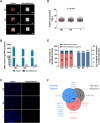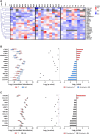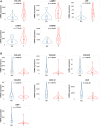Proteomic Identification of a Gastric Tumor ECM Signature Associated With Cancer Progression
- PMID: 35340765
- PMCID: PMC8942767
- DOI: 10.3389/fmolb.2022.818552
Proteomic Identification of a Gastric Tumor ECM Signature Associated With Cancer Progression
Abstract
The extracellular matrix (ECM) plays an undisputable role in tissue homeostasis and its deregulation leads to altered mechanical and biochemical cues that impact cancer development and progression. Herein, we undertook a novel approach to address the role of gastric ECM in tumorigenesis, which remained largely unexplored. By combining decellularization techniques with a high-throughput quantitative proteomics approach, we have performed an extensive characterization of human gastric mucosa, uncovering its composition and distribution among tumor, normal adjacent and normal distant mucosa. Our results revealed a common ECM signature composed of 142 proteins and indicated that gastric carcinogenesis encompasses ECM remodeling through alterations in the abundance of 24 components, mainly basement membrane proteins. Indeed, we could only identify one de novo tumor-specific protein, the collagen alpha-1(X) chain (COL10A1). Functional analysis of the data demonstrated that gastric ECM remodeling favors tumor progression by activating ECM receptors and cellular processes involved in angiogenesis and cell-extrinsic metabolic regulation. By analyzing mRNA expression in an independent GC cohort available at the TGCA, we validated the expression profile of 12 differentially expressed ECM proteins. Importantly, the expression of COL1A2, LOX and LTBP2 significantly correlated with high tumor stage, with LOX and LTBP2 further impacting patient overall survival. These findings contribute for a better understanding of GC biology and highlight the role of core ECM components in gastric carcinogenesis and their clinical relevance as biomarkers of disease prognosis.
Keywords: biomarker; extracellular matrix (ECM); gastric cancer; matrisome; proteomics.
Copyright © 2022 Moreira, Ferreira, Carneiro, Figueiredo, Osório, Barbosa, Preto, Pinto-do-Ó, Carneiro and Seruca.
Conflict of interest statement
The authors declare that the research was conducted in the absence of any commercial or financial relationships that could be construed as a potential conflict of interest.
Figures





Similar articles
-
The cancer matrisome: From comprehensive characterization to biomarker discovery.Semin Cell Dev Biol. 2019 May;89:157-166. doi: 10.1016/j.semcdb.2018.06.005. Epub 2018 Jul 13. Semin Cell Dev Biol. 2019. PMID: 29964200 Review.
-
Up-regulation of type I collagen during tumorigenesis of colorectal cancer revealed by quantitative proteomic analysis.J Proteomics. 2013 Dec 6;94:473-85. doi: 10.1016/j.jprot.2013.10.020. Epub 2013 Oct 24. J Proteomics. 2013. PMID: 24332065 Clinical Trial.
-
Tumor decellularization reveals proteomic and mechanical characteristics of the extracellular matrix of primary liver cancer.Biomater Adv. 2023 Mar;146:213289. doi: 10.1016/j.bioadv.2023.213289. Epub 2023 Jan 18. Biomater Adv. 2023. PMID: 36724550
-
Characterization of glomerular extracellular matrix by proteomic analysis of laser-captured microdissected glomeruli.Kidney Int. 2017 Feb;91(2):501-511. doi: 10.1016/j.kint.2016.09.044. Epub 2016 Dec 15. Kidney Int. 2017. PMID: 27988214 Free PMC article.
-
The Extracellular Matrix: An Accomplice in Gastric Cancer Development and Progression.Cells. 2020 Feb 8;9(2):394. doi: 10.3390/cells9020394. Cells. 2020. PMID: 32046329 Free PMC article. Review.
Cited by
-
Lysyl Oxidase Promotes the Formation of Vasculogenic Mimicry in Gastric Cancer through PDGF-PDGFR Pathway.J Cancer. 2024 Feb 4;15(7):1816-1825. doi: 10.7150/jca.92192. eCollection 2024. J Cancer. 2024. PMID: 38434983 Free PMC article.
-
MatrisomeDB 2.0: 2023 updates to the ECM-protein knowledge database.Nucleic Acids Res. 2023 Jan 6;51(D1):D1519-D1530. doi: 10.1093/nar/gkac1009. Nucleic Acids Res. 2023. PMID: 36399478 Free PMC article.
-
Role and value of the tumor microenvironment in the progression and treatment resistance of gastric cancer (Review).Oncol Rep. 2025 Jan;53(1):14. doi: 10.3892/or.2024.8847. Epub 2024 Nov 29. Oncol Rep. 2025. PMID: 39611496 Free PMC article. Review.
-
Identification of potential shared gene signatures between gastric cancer and type 2 diabetes: a data-driven analysis.Front Med (Lausanne). 2024 Jun 6;11:1382004. doi: 10.3389/fmed.2024.1382004. eCollection 2024. Front Med (Lausanne). 2024. PMID: 38903804 Free PMC article.
-
Data-independent acquisition and quantification of extracellular matrix from human lung in chronic inflammation-associated carcinomas.Proteomics. 2023 Apr;23(7-8):e2200021. doi: 10.1002/pmic.202200021. Epub 2022 Oct 13. Proteomics. 2023. PMID: 36228107 Free PMC article.
References
-
- Bartha Á., Győrffy B. (2021). TNMplot.com: A Web Tool for the Comparison of Gene Expression in Normal, Tumor and Metastatic Tissues. Ijms 22 (5), 2622. 10.3390/ijms22052622 - DOI - PMC - PubMed
LinkOut - more resources
Full Text Sources
Miscellaneous

